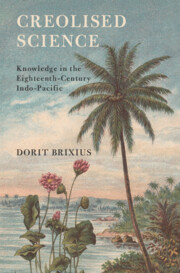Refine search
Actions for selected content:
10306 results in History of science: general interest
Kathleen M. Crowther, Policing Pregnant Bodies from Ancient Greece to Post-Roe America Baltimore: Johns Hopkins University Press, 2023. Pp. 288. ISBN 978-1-4214-4763-6. $29.95 (hardcover).
-
- Journal:
- The British Journal for the History of Science / Volume 57 / Issue 4 / December 2024
- Published online by Cambridge University Press:
- 11 April 2024, pp. 663-664
- Print publication:
- December 2024
-
- Article
- Export citation
Timothy W. Lorek, Making the Green Revolution: Agriculture and Conflict in Colombia Chapel Hill: University of North Carolina Press, 2023. Pp. 342. ISBN 978-1-4696-7382-0. $34.95 (paperback).
-
- Journal:
- The British Journal for the History of Science / Volume 57 / Issue 4 / December 2024
- Published online by Cambridge University Press:
- 11 April 2024, pp. 655-657
- Print publication:
- December 2024
-
- Article
- Export citation
1 - The Limits of French Colonial Visions and Science
-
- Book:
- Creolised Science
- Published online:
- 03 April 2024
- Print publication:
- 04 April 2024, pp 18-50
-
- Chapter
- Export citation
Index
-
- Book:
- Creolised Science
- Published online:
- 03 April 2024
- Print publication:
- 04 April 2024, pp 252-258
-
- Chapter
- Export citation
Abbreviations
-
- Book:
- Creolised Science
- Published online:
- 03 April 2024
- Print publication:
- 04 April 2024, pp xiv-xvi
-
- Chapter
- Export citation
Conclusion
-
- Book:
- Creolised Science
- Published online:
- 03 April 2024
- Print publication:
- 04 April 2024, pp 212-215
-
- Chapter
- Export citation
Bibliography
-
- Book:
- Creolised Science
- Published online:
- 03 April 2024
- Print publication:
- 04 April 2024, pp 216-251
-
- Chapter
- Export citation
Contents
-
- Book:
- Creolised Science
- Published online:
- 03 April 2024
- Print publication:
- 04 April 2024, pp vii-vii
-
- Chapter
- Export citation
6 - Materials, Environment, and the Application of Knowledge
-
- Book:
- Creolised Science
- Published online:
- 03 April 2024
- Print publication:
- 04 April 2024, pp 183-211
-
- Chapter
- Export citation
3 - Agriculture and Everyday Knowledge
-
- Book:
- Creolised Science
- Published online:
- 03 April 2024
- Print publication:
- 04 April 2024, pp 80-117
-
- Chapter
- Export citation
2 - The Acquisition of Knowledge and Plants, from Madagascar to China
-
- Book:
- Creolised Science
- Published online:
- 03 April 2024
- Print publication:
- 04 April 2024, pp 51-79
-
- Chapter
- Export citation
4 - Enslaved People as Knowledge Carriers
-
- Book:
- Creolised Science
- Published online:
- 03 April 2024
- Print publication:
- 04 April 2024, pp 118-155
-
- Chapter
- Export citation
Figures
-
- Book:
- Creolised Science
- Published online:
- 03 April 2024
- Print publication:
- 04 April 2024, pp viii-viii
-
- Chapter
- Export citation
Dedication
-
- Book:
- Creolised Science
- Published online:
- 03 April 2024
- Print publication:
- 04 April 2024, pp v-vi
-
- Chapter
- Export citation
5 - The Cross-Cultural Quest for Spices in South East Asia
-
- Book:
- Creolised Science
- Published online:
- 03 April 2024
- Print publication:
- 04 April 2024, pp 156-182
-
- Chapter
- Export citation
Acknowledgements
-
- Book:
- Creolised Science
- Published online:
- 03 April 2024
- Print publication:
- 04 April 2024, pp ix-xii
-
- Chapter
- Export citation
Copyright page
-
- Book:
- Creolised Science
- Published online:
- 03 April 2024
- Print publication:
- 04 April 2024, pp iv-iv
-
- Chapter
- Export citation
Author’s Note
-
- Book:
- Creolised Science
- Published online:
- 03 April 2024
- Print publication:
- 04 April 2024, pp xiii-xiii
-
- Chapter
- Export citation
Introduction
-
- Book:
- Creolised Science
- Published online:
- 03 April 2024
- Print publication:
- 04 April 2024, pp 1-17
-
- Chapter
- Export citation

Creolised Science
- Knowledge in the Eighteenth-Century Indo-Pacific
-
- Published online:
- 03 April 2024
- Print publication:
- 04 April 2024
